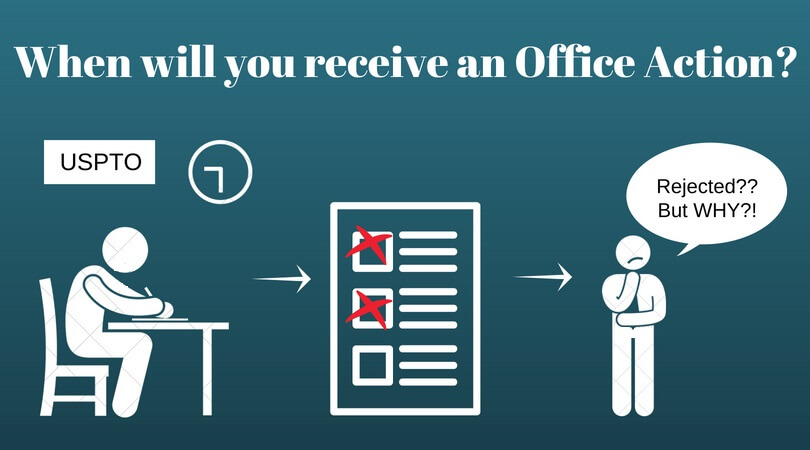Office Action is the opposition notified by the USPTO examiner in the patent application to point out some or all patent claims that contain issues. It is an official mode of communication between the patent examiner and the patent filer that clearly state areas of improvement, mistakes, or rejection, in the patent application. These are specified to make possible changes in the form that could clarify or pass the form from the patent examination. It is a standard part of the procedure, and the next step is to respond to those objections and await potential future Office Actions. The examiner on the other side allows amendments in the patent application in the form of ‘Office Action Response’, which was sent by the applicant after correcting or modifying the areas of claims that had issues. Here we will refer to the office action causes and how to respond to them.
Response to first Office Action can either include arguments against the rejections made by the examiner or amendments in claims to overcome the examiner’s rejection(s). One must always take care while filing a response to an Office Actions, as negligence towards issues will lead to second rejection. Before understanding the possible responses to Office Action, it is essential to learn about the numerous possible motives an examiner may issue a denial. Nearly all applications obtain at least one Office Action; therefore, to know ‘how to possibly send a positive response’ is a must for the inventor. Knowing what you are reading gives you an advantage on what to do next and how to strategize your next move.
Also Read: Patent Paralegal Force
Office Action Causes
Let’s understand the various possible causes of getting an office action from the patent examiner. The following are the major causes of its rejection:
- Issues in specification format (§ 112): Most generalized reason to receive an office action is the inattentiveness towards the specification format. Formatting is a fundamental part of the patent application which most applications fail to meet regarding specifications. According to section 112, these may include errors from the most fundamental problems like line spacing, font size, and header format, to the most complex ones, such as the issues in the formatting of the claims section. The claims must be well-written and relevant enough to support the claims with complete detailed description intact in it. Also, it must be written using appropriate and unambiguous language in an organized format. Since, formatting needs to be as per the formatting specified by the USPTO, or any other registered filing organization; it can only be corrected. The applicant has to make changes in the claims section to make it more precise in a manner they entirely reflect the scope of the invention. In that case, taking help from an experienced patent firm is highly recommended.
- Issues in subject matter (§ 101): Sometimes, applications might get office action because their invention does not match with the subject or the title specified. In legal terms, the applicant receives an office action if the invention is not considered to be a patentable subject matter. It requires amendment in the claims section to prove that the invention is not abstract and is operational in nature. In case the applicant has filed a patent application for completely new technology for which he/she is unable to present a prototype or its operational model, he/she can submit declarations from experts who have previously conducted experiments related to the invention.
- Issues of Novelty (§ 102): A widespread mistake is to put the same claims in the application. According to Section 102, if one or more claims of your application match identically with the claims present in any previously filed patent application, then this will cause an issue of an Office Action. Either the applicant can argue for the novelty of his/her specified claims part or make changes according to the questionable/objectionable part. The applicant can try to convince the examiner for the novelty of his/her claims on the phone or through arranging a meeting with the examiner.
- Issues of Obviousness (§ 103): According to Section 103, claims must be disclosed in a manner that clearly states that the invention is entirely non-obvious. It means that the invention must prove to be wholly new and not a derivative of the previous patent. Even if, it is a derivative, it must not be simple to get derived from any skilled person that holds background subject knowledge regarding the invention. These office actions are the most difficult to determine and cured since patent examiners consider several guidelines, factors, and tests to infer that whether or not is it a case of obviousness. Similar amendments have to be made to make the application free from this factor.
- Issues of Double Patenting: Examiner can file office action when he finds that the application has already been claimed in an earlier patent by the same inventor. It points out a direct violation of “one invention, one patent” rule. In other words, the Examiner feels that you have filed two applications for the same invention. Filing a “Terminal Disclaimer” would cure the application from this issue, saving it from the subject of an office action.
What is a Final Office Action & how to respond to it?
When the inventor consecutively fails in every act of his/her to correct the issues rose by the examiner through all of his office action responses, the examiner is entitled to issue a Final Office Action. It depicts as the last chance to correct the notified issues from the applicant’s end, and that must satisfy the issues raised by the examiner; otherwise, the application is abandoned. It is evident that first office action can never be considered as final office action since first actions only state the issues that must be rectified. And the second action says the matters which were left unresolved from the first office action response. The applicant can either accept the rejection and stop his/her work or make an appeal for the issues that have been raised are incorrect. He can even request for continuous examination.
The first alternative means that the inventor feels that all the issues raised by the examiner are convincing and cannot be incredulous. While if he/she wants to prove the correctness of the work, then he/she can appeal to PTAB (Patent Trial and Appeal Board). Once the application gets rejected by the examiner twice in a row for the claim (one or more, if applicable), one becomes eligible to file an appeal. Another alternative is that if he/she files a request for continuous examination (RCE) by paying the respective fee. This enables the examiner to provide the applicant with another opportunity to claim the correctness of his/her work even after receiving final Office action, and or make amendments to the claims.
We can help you!
We facilitate you with comprehensive Official Action Response services so you can focus on other core aspects of your application. With this service we will be sending individual notifications on each action, will be distributing reports listing each action received and filed in a given timeframe, or we can update a file management system or database instead of sending formal notifications.
For more queries, please visit our service page.
Related Articles:
How to Avail Best Patent Search Services?
Patent Docketing Need in IP Lifecycle


